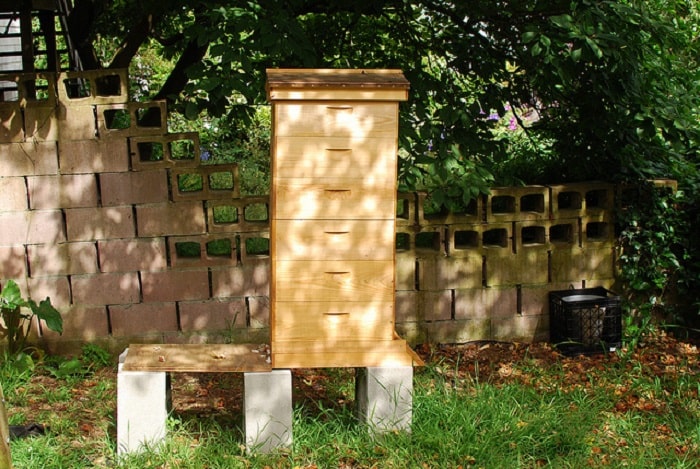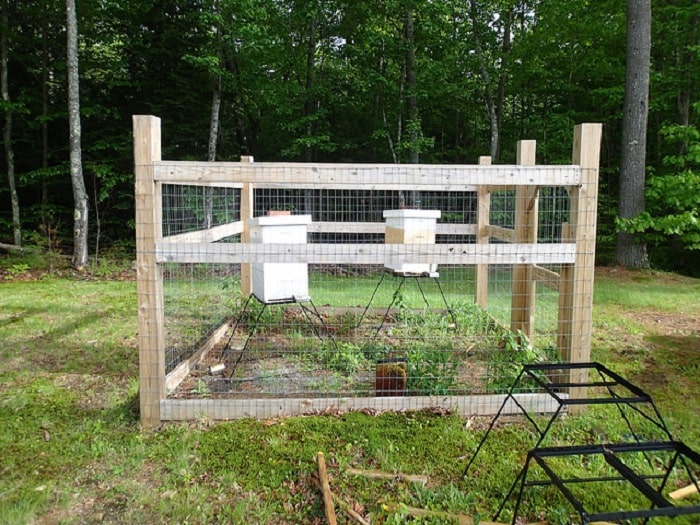As a beginner beekeeper, you may encounter a surprising number of contradicting advice regarding beehive placement. We’ve discovered that the simplest solutions are frequently the best. This holds true for the height of your beehive above the ground. So, how high should a beehive be off the ground?

How high do you place your hive?
We were startled when we started studying online what other individuals thought was the best beehive height. Some of these suggested heights ranged from 18 inches to 8 feet in the air! That is simply not feasible for business operators, let alone hobbyists.
Placing a beehive 2 or 3 feet off the ground with a dedicated hive stand is ideal for a hobbyist, but it is impractical as your apiary grows. Setting up your hives 4 or 5 feet in the air, on the other hand, is a totally different story, and we are not talking about swarm traps here. This is something no one else does, and good luck inspecting your hives without damaging your back.
The majority of commercial beekeeping operations use wooden pallets as beehive platforms. Some smaller beekeeping operations will employ a combination of concrete cinder blocks, wooden pallets, or simply laying out 24s on the ground. All of these are basic, low-cost alternatives that keep their hives within 6 to 10 inches of the ground.
Reasons to use a beehive stand?
There are many reasons to use a beehive stand. In fact, beehive stands benefit both the beekeeper and the bees.
- It makes life easier for the beekeeper
Beekeeping is a physically demanding pastime that demands a lot of bending and lifting. Back pain can also be caused by hunching over during hive inspections. Using a hive stand, on the other hand, is a straightforward solution to solve this problem. The hive will be at waist level with a correct beehive stand height of 18 inches, which is a comfortable level for the beekeeper to operate on without having to bend down so much.
- Maintains the hive’s dryness
A hive stand is vital because it keeps the beehive dry by lifting it above ground. Mold, mildew, and wood rot are all possibilities in beehives that are frequently exposed to damp ground. As a result, having a hive stand allows you to use your beehive for a longer period of time.
- Pests and Predators
Keeping a beehive upright also aids in the control of pests and predators. Insects and creatures are more prone to assaulting a ground-based hive. There are also various strategies for preventing and deterring ants while using a hive stand.
- Accessible entrance
Bees find it easier to enter the hive with the support of the hive support. Because the entrance to beehives on the ground is likely to be obstructed by grass and weeds. If the entrance is hidden by such foliage, the bees may have a more difficult time going in. A hive stand raises the beehive to a good height, allowing for a clear, unobstructed entry.

>>> Read more: Where does bees go in the winter?
What should I put under my bee hives?
One of the most important things you can do to ensure the success of your hive is that you place your hive in the right location. Here are some ideas for you:
- Sun or shade or both.
- No direct wind.
- Space between.
- Near water source.
Is it necessary to level beehives?
It is not critical to be completely level while constructing your beehives. In truth, no beekeeper is going to take a level to all of their beehives and inspect them. You are probably going to eyeball it and not use a level to check your hives. You do not want your beehive to be at an extreme angle, but you do need to place your hives on general level dry land. It is nice to have the beehive a few millimeters lower on the front to aid with water flowing off the top, but it is not that important.
Another typical problem occurs when you give your honeybees sugar. When stacking gallon size pails or jars on top of your hives, you want the hives to be reasonably level. This will create a good vacuum seal between the bucket and the hive’s top. Otherwise, the syrup will run out before the bees can swallow it.
As previously said, no one uses an actual level to inspect their hives; it is unrealistic, and people simply eyeball it. Most commercial companies, large and small, use wooden pallets and do not bother with leveling their hives. They just lay their hive pallets on dry, somewhat level ground.

Related questions
Q. What direction should a beehive face?
Bees do not care what direction their hive is facing. In the wild, bees have not shown a statistical preference for one orientation for the front of their hives. Bees are adaptable and will adapt to their surroundings.
Q. How near together can beehives be placed?
It is advised that your hives be spaced at least two feet apart. This is not a hard and fast rule, but it helps make examining your hives easier. If you disturb one hive, you are less likely to disturb the other hives if they are not close together.
Q. What time of day is optimal for inspecting a beehive?
The best time to inspect your hives is between 11 a.m. and 4 p.m. on a calm, warm, sunny day. Instead of guarding the hive, the forager bees will be out working. Flying bees are contented bees.
Related Posts:
